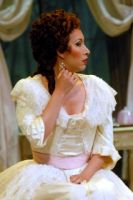
"Figaro" a Hit (Again)
Thanks for the Mozart.
It didn’t hurt a bit
With Sir Roger in the pit.
We’ve scarcely heard
Such artistry,
the Count took quite a hit.
Yes, thank you so much.
Cincinnati Opera’s “Marriage of Figaro,” may be the operatic hit of 2009.

First salvo of Cincinnati Opera’s Spanish-themed summer festival, the hit of 1786 had everything: vocal and visual allure, great acting, a large and engaged audience and most of all, Mozart’s divine music led by one of his foremost living interpreters, authentic performance practice expert Sir Roger Norrington who had the Cincinnati Symphony Orchestra -- pure luxury casting -- at his fingertips.
The singers were well matched to their characters. Jonathan Lemalu and soprano Sarah Tynan exuded spirit in abundance as the nuptial pair Figaro and Susanna confronted the prospect of Count Almaviva asserting the “droit du Seigneur,” or the lord’s right to have the first night with his vassal's bride. Her sweet, light soprano complemented his bluff baritone, which he tempered slyly in his act one “Se vuol ballare, Signore Contino” in which Figaro resolves to defeat the Count at his own game.
The Count and Countess, soprano Nicole Cabell
and baritone Teddy Tahu Rhodes, made an imposing couple. Cabell possessed the evening’s most beautiful
voice, showcased most affectingly in the Countess’ grieving “Porgi amor” (act
two) and “Dove sono” (act three).
Rhodes, a tall hunk who flaunted his bare, rippled chest beneath an
opening dressing gown. Rhodes displayed a handsome, well-modulated voice, on the dark
side but surprisingly nimble, as in his act three “Hai gia vinta la causa” where
the overweening Count scorns the lowly Figaro for daring to challenge him.

Mezzo-soprano Marie
Lenormand as Cherubino provided some of the evening’s brightest moments as the
love-besotted page boy who finds himself in one compromising situation after
another. Her voice had sheen (“Voi che
sapete,” act one) and enough weight to make Cherubino a credible rival to the jealous
Count for the Countess’ love. Lenormand’s
considerable comic flair was re-doubled when Cherubino was disguised as a girl
to avoid conscription into the military.
Mezzo Judith Christin as Marcellina and bass Bruno Pratico as Dr. Bartolo, who find themselves to be Figaro’s long-lost parents, thus spoiling the Count’s plan to punish Figaro by marrying him off to Marcellina, were a perfect comic pair. And so was the great character actor, baritone Thomas Hammons as the drunken gardener Antonio.
Ensembles, one of the many glories of Mozart, were vibrant and crisply articulated. The CSO was a fully equal partner and what a thrill it was to hear lines and colors often obscured emerge distinctly through the musical fabric. Director James Alexander’s job was doubtless a happy one with such a talented cast to work with and stage action was split-second, witty and in sync with the music.
The production, built by the Banff Centre for the Arts, was a simple one, just a platform with pieces of furniture set against the interior walls of the Count’s palace (acts one-three) and a garden with statuary in act four. The process of “optimizing Music Hall for opera,” begun during former Cincinnati Opera artistic director Nicholas Muni’s tenure, made accommodation of “Figaro” in the 3,516-seat hall a felicitous one, with the proscenium arch covered in black, the stage curtains partially drawn and the set standing against a black background to draw the eye into the action.
This allowed maximization of what counts most in “Figaro,” human beings interacting with one other through music.
Repeat is 7:30 p.m.
June 13 at Music Hall.
* from “The
Big Broadcast of 1938,” the film starring Bob Hope where his theme song, “Thanks for the Memory,” was introduced